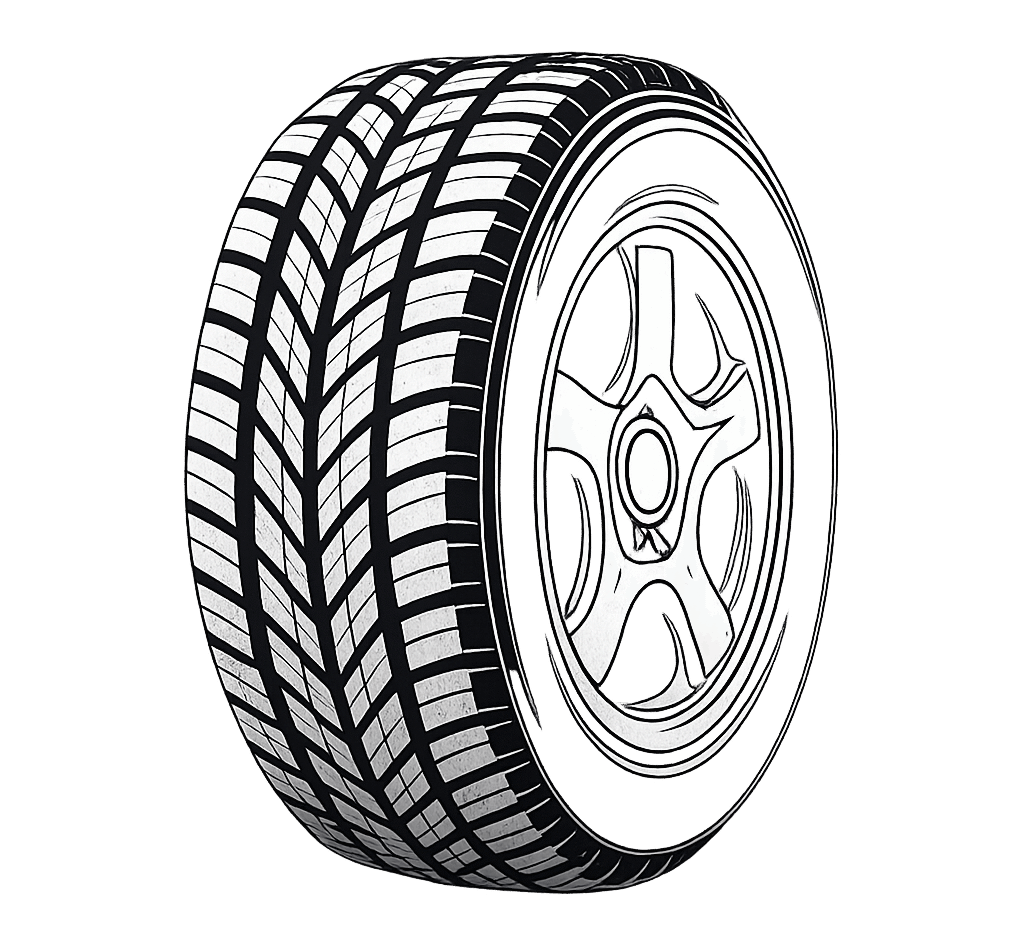Ultimate Tire Maintenance Guide: Keep Your Tires Safe & Lasting Longer.
Last updated on September 2nd, 2025
Tires are one of the most important parts of your car, yet many drivers don’t think about them until something goes wrong. Proper tire care is not only about saving money—it’s about safety, comfort, and getting the best performance from your vehicle. In this guide, we’ll explain easy steps for tire maintenance, share expert tips, and answer common questions so you can drive with confidence. Whether you’re looking for the best tires for your car or simple upkeep advice, this article will help you make smart decisions.
Who This Guide Is For
This guide is for anyone who wants safer driving and longer-lasting tires. It’s especially useful if you’re:
- Daily commuters
- Families with kids
- New drivers learning the basics
- DIYers who like to handle simple car care
- Long-distance drivers
Quick “What You’ll Need”
Before you start, keep these handy:
- Tire pressure gauge
- Car jack
- Basic hand tools (like a lug wrench)
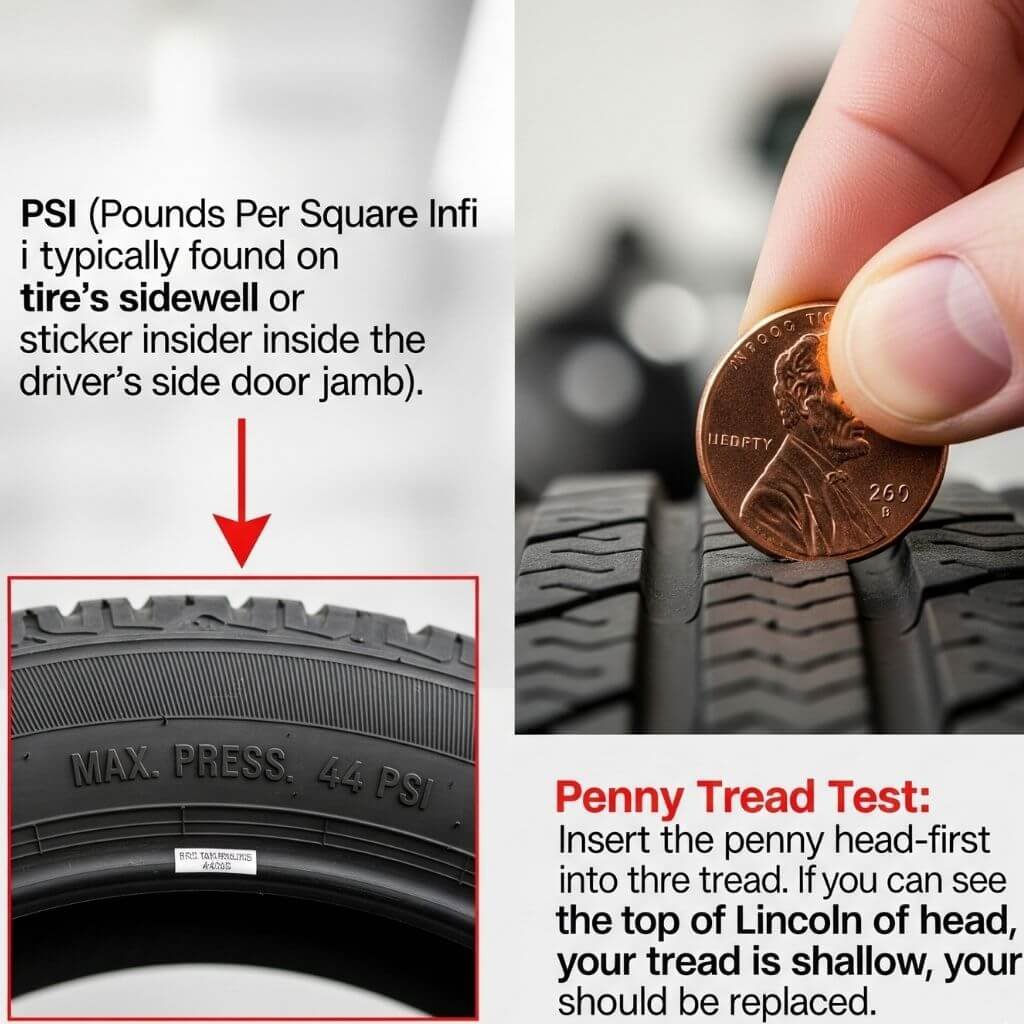
Quick 5-Minute Tire Check — Immediate Actions
You don’t need to be a mechanic to keep your tires safe. In just five minutes, you can spot problems early and avoid costly repairs. Follow these simple steps:
- Check tire pressure
Use a tire pressure gauge. The correct PSI (pounds per square inch) is printed on a sticker inside your driver’s door—not on the tire itself. If the number is too low, add air. If it’s too high, release some. - Do the penny test for tread depth
Place a penny into the tire tread with Lincoln’s head upside down. If you can see the top of his head, your tires are too worn and need replacing. - Look for damage
Walk around the car. Watch for bulges, cracks, or nails stuck in the rubber. These are signs your tire may fail soon. - Check the spare tire
Make sure it’s inflated and ready in case of emergencies.
👉 Action tip: If you find low tread, unusual bulges, or anything stuck in the tire, visit a tire shop right away.
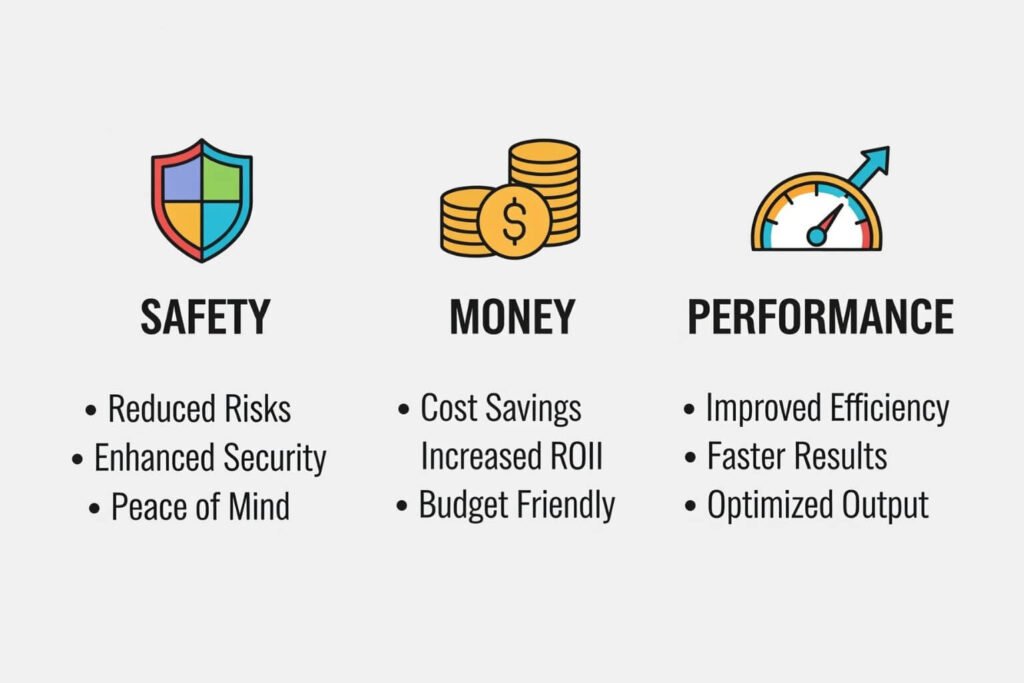
Benefits of Regular Tire Maintenance — The “Why”
Taking a few minutes to care for your tires can make a big difference. Here’s why it matters:
- Safety first
Well-maintained tires mean fewer blowouts and better control of your car. Good tread and proper pressure help your brakes work faster and your steering stay sharp. - Save money
Tires last longer when you keep them in good shape. According to the U.S. Department of Energy, correct tire pressure can also improve gas mileage, saving you money at the pump. AAA notes that worn or damaged tires are one of the top reasons for roadside breakdowns—something easy to avoid. - Comfort and performance
Healthy tires give you a smoother, quieter ride with less vibration, especially on highways. - Good for the environment
Longer-lasting tires mean fewer replacements and less waste in landfills. It’s a small step that helps the planet.
👉 Bottom line: Regular checks keep you safer, save money, and make driving more enjoyable.
Step-by-Step Tire Maintenance Tasks
Keeping your tires in top shape doesn’t have to be complicated. With a few basic tools and some regular attention, you can extend tire life, improve safety, and save money. Below are the most important tasks, explained step by step.
1. Check & Set Tire Pressure
What it is: Tire pressure is the amount of air inside your tires, measured in PSI (pounds per square inch). Driving with the wrong pressure is one of the most common tire mistakes.
Why it matters:
- Underinflated tires wear out faster, reduce fuel economy, and increase blowout risk.
- Overinflated tires can reduce traction and make the ride rough.
How to do it (step by step):
- Find the correct PSI on the sticker inside your driver’s door.
- Remove the tire’s valve cap.
- Press a digital gauge firmly onto the valve.
- Read the PSI.
- If low, use an air compressor to add air in short bursts. If too high, press the valve pin to let some air out.
- Recheck until the PSI matches the sticker.
- Replace the cap.
Frequency: Check monthly and before long trips.
Tools: Digital tire gauge ($10–$40), small portable compressor (optional).
Signs you need pro help: If a tire keeps losing air, it may have a slow leak, nail, or valve problem.
Time & cost: 5 minutes per tire; free to a few dollars at a gas station.
2. Inspect Tread Depth & Wear
What it is: Tread depth is the thickness of the grooves in your tire. It helps grip the road, especially in rain or snow.
Why it matters: Worn-out tread increases stopping distance, makes hydroplaning more likely, and reduces traction in bad weather.
How to do it:
- Penny Test: Place a penny into the tread with Lincoln’s head down. If you can see the top of his head, the tread is too low (below 2/32″).
- Tread Depth Gauge: A small tool (about $5) gives an exact reading.
Frequency: Every 2–3 months.
Signs you need pro help: If tread is uneven (more worn on one side), it may mean your alignment is off.
Time & cost: 5 minutes; pennies are free, tread gauges cost a few dollars.
3. Rotate Tires
What it is: Rotating tires means moving them to different positions on your vehicle.
Why it matters: Tires wear at different rates depending on whether they’re on the front or rear. Rotation ensures even wear and longer tire life.
How to do it:
- Front-to-back: For most cars with non-directional tires, move the front tires to the back and the back tires to the front.
- X-pattern: Swap front right to back left, and front left to back right.
- Note: Directional tires (with one-way tread patterns) should only be moved front to back, not side to side.
Frequency: Every 5,000–7,500 miles, or with every oil change.
DIY vs. shop: You’ll need a jack, jack stands, and a wrench if doing it yourself. Many shops include rotation for free with oil changes.
Time & cost: 30–60 minutes DIY; $20–$50 at a shop.
4. Wheel Balance & Alignment
What it is:
- Balancing: Ensures weight is distributed evenly around the wheel.
- Alignment: Adjusts suspension so tires meet the road correctly.
Why it matters: Poor alignment or balance causes uneven wear, pulling to one side, or steering wheel vibrations.
When to do it:
- Balancing: When new tires are installed or if you feel vibration at certain speeds.
- Alignment: Once a year, after hitting a pothole, or if your car pulls to one side.
Cost: Balancing ($40–$75), alignment ($75–$150).
Time: 30–90 minutes at a shop.
5. Repairing Punctures (Plugs vs. Patches)
What it is: Fixing small holes in the tire tread.
Why it matters: Driving on a punctured tire can cause blowouts or complete failure.
Safe repairs:
- Holes in the tread area can usually be patched or plugged.
- Holes in the sidewall or shoulder cannot be safely repaired—replace the tire.
When to replace: If the hole is larger than ¼ inch or near the sidewall.
Time & cost: A shop patch costs $15–$30. Quick DIY plugs are cheap but not as reliable as professional patches.
6. Cleaning & Protectants
What it is: Washing dirt and chemicals off tires and applying protective products.
Why it matters: Road salt, dirt, and UV rays can dry out and weaken rubber.
How to do it:
- Rinse with water.
- Wash with mild soap and a soft brush.
- Rinse thoroughly.
- Dry completely.
- Apply a water-based protectant (avoid harsh, solvent-based sprays that crack rubber).
Frequency: As needed—monthly is a good rule of thumb.
Time & cost: 15 minutes; soap and brush are inexpensive.
7. Storing Tires (Seasonal)
What it is: Proper storage for tires you’re not using, such as winter or summer sets.
Why it matters: Improper storage can cause cracking, flat spots, or dry rot.
How to do it:
- Clean tires thoroughly.
- Place each in a dark plastic bag and remove as much air as possible.
- Store upright (not stacked) in a cool, dry place away from sunlight and heat.
- If stacking, don’t go higher than four tires, and rotate the stack occasionally.
Frequency: Anytime tires are stored for more than a few weeks.
Time & cost: 30 minutes; storage bags cost about $20 for a set.
Tire maintenance doesn’t require advanced skills—just regular attention. By checking pressure, inspecting tread, rotating, and addressing small issues early, you can extend tire life, save money, and drive with more confidence.
Ingredients Comparison
When we talk about “ingredients” in tire care, we can look at two sides: what tires themselves are made of and what goes into the products we use to care for them. Both matter because the materials affect how tires perform, wear, and respond to cleaning or protection.
Tire Composition & Compounds
Tires may look like simple black circles, but they are built from different layers and materials:
- Rubber compounds: A mix of natural and synthetic rubber. Softer rubbers (used in winter tires) grip well in cold but wear faster in heat. Harder rubbers (used in summer or highway tires) last longer but don’t stay soft in freezing weather.
- Fillers (silica vs. carbon black): Silica helps reduce rolling resistance for better fuel economy and wet traction. Carbon black is tough and makes tires more resistant to wear.
- Belts (steel or polyester): Steel belts add strength and help the tire hold its shape. Polyester belts make the ride smoother.
- Sidewall construction: A strong sidewall resists cuts and scrapes, while a softer one offers more comfort.
How this affects maintenance:
- Winter tires need to be rotated more often because their softer compounds wear down quickly in warm weather.
- All-terrain tires with chunky tread can trap stones or debris, so regular checks are important.
- Tires with high-silica compounds may hold air pressure better, but still need monthly checks.
Takeaway: Match your maintenance routine (like rotation schedule and pressure checks) to the type of tire you use.
Tire Care Product “Ingredients”
Tire care products also use different formulas. Here are the main types:
- Solvent or silicone-based dressings: Create a glossy shine but can attract dirt. Some harsh solvents may dry out rubber.
- Water-based dressings (polymer): Give a natural look, are safer for rubber and trim, and don’t leave a sticky feel.
- Wax-based products: Offer good protection against sun and water but may need more frequent reapplication.
- Cleaners (alkaline or pH-balanced): Alkaline cleaners cut through heavy grime but may be too strong for regular use. pH-balanced cleaners are gentler and safe for frequent cleaning.
Safety notes:
- Avoid products with petroleum solvents—they can crack rubber over time.
- Check that cleaners and dressings are safe for vehicles with TPMS sensors.
- Use sprays carefully—don’t flood valve stems with heavy aerosols.
Quick Comparison
| Tires | Care Products |
| Softer winter rubber = wears faster in heat | Silicone-based = high shine, attracts dirt |
| Silica compound = better wet grip | Water-based = safer, natural finish |
| Steel belts = strength & durability | Wax-based = sun & water protection |
| Chunky tread = traps stones | pH-balanced cleaner = gentle, everyday safe |
Tools & Pricing — What to Expect
Taking care of your tires doesn’t have to be expensive. Some tools are one-time buys that last for years, while services at the shop come with set price ranges. Knowing these costs helps you plan a budget and avoid surprises.
Key tools and services:
- A digital tire gauge is the most important tool. It lets you check your pressure in seconds, and accurate readings can save you from early tire wear.
- A portable air compressor is handy for topping up pressure at home or on road trips.
- Routine shop services like rotation, alignment, and balancing keep tires wearing evenly and make your car safer.
- Repairs, new tires, and sensor replacements are bigger expenses, but they’re usually less costly than ignoring problems.
Cost-saving tip:
Regular rotation and keeping the correct pressure can add thousands of miles to your tire life. For example, if a set of tires normally lasts 40,000 miles but you extend it to 50,000 with good care, you could save the cost of one whole tire set over the life of your vehicle.
Tire Tools & Service Price Guide
| Tool/Service | Typical Price Range | DIY vs. Pro | Notes |
| Digital tire gauge | $10–$40 | DIY | Look for a calibrated digital model |
| Portable air compressor | $40–$150 | DIY | Great for road trips and emergencies |
| Tire rotation | $20–$100 | Pro | Sometimes free with oil change |
| Wheel alignment | $75–$200 | Pro | Needed yearly or after suspension work |
| Tire balancing | $10–$25 per wheel | Pro | Done when installing or fixing vibrations |
| Tire repair (patch/plug) | $10–$40 | Pro | Safe only for center tread area |
| New tire (economy–premium) | $80–$350 each | Pro | Varies by size and brand |
| TPMS sensor replacement | $40–$150 each | Pro | Needed if sensor battery dies |
Real-World Mini Case Studies
Sometimes the best way to understand tire care is to look at real-life examples. Simple experiments can show how small changes in maintenance make a big difference in safety, cost, and tire life.
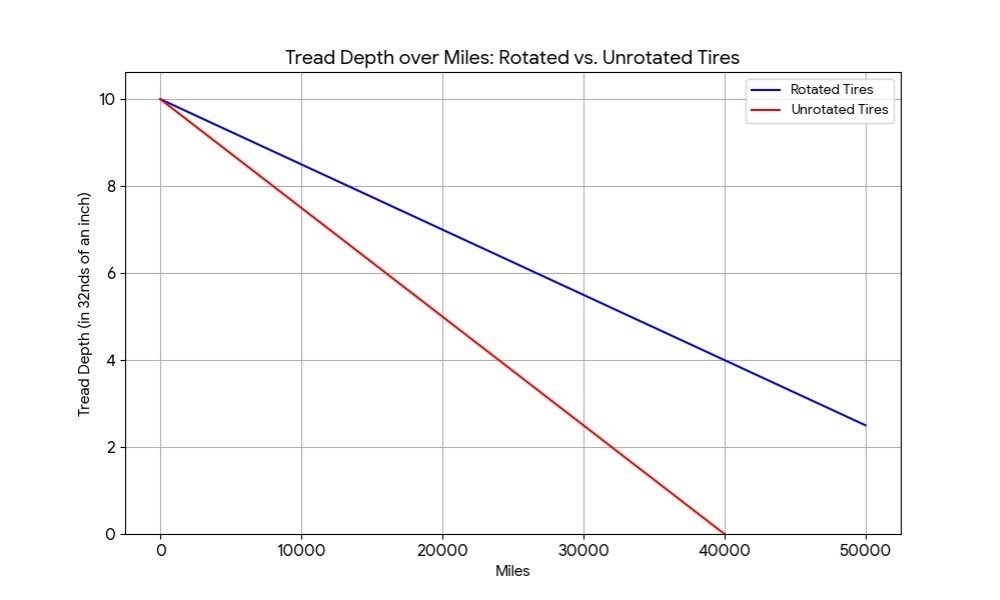
Case Study 1: Tire Rotation Frequency
- Hypothesis: Rotating tires every 6,000 miles will make them last longer than rotating every 12,000 miles.
- Method: Two cars of the same model drive similar routes. One rotates at 6,000 miles, the other at 12,000. Tread depth is measured every 3,000 miles.
- Data to collect: Mileage, tread depth (in 32nds of an inch), wear pattern.
- Results: The 6,000-mile rotation car kept even tread for 50,000 miles. The 12,000-mile rotation car showed uneven wear at 40,000 miles, needing earlier replacement.
- Takeaway: Sticking to shorter rotation intervals can add 10,000 miles or more to tire life, saving $300–$600 per set.
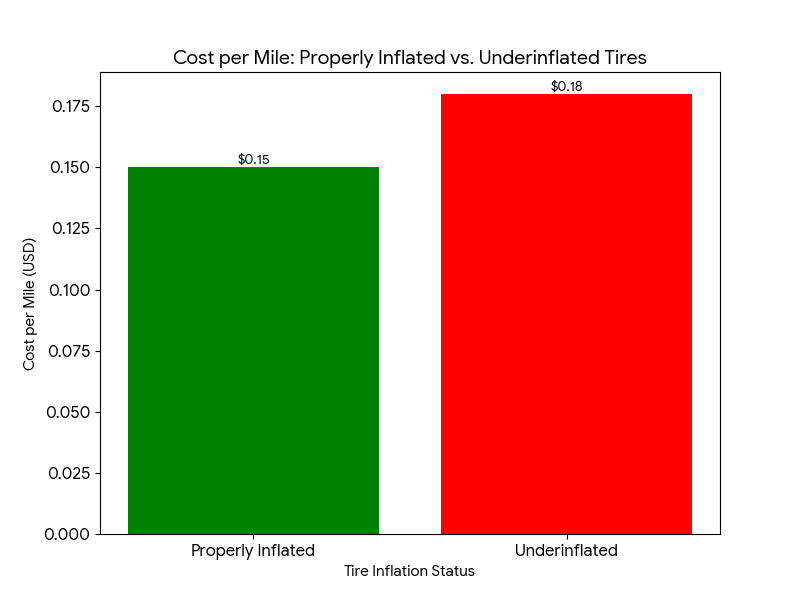
Case Study 2: Underinflation and Fuel Use
- Hypothesis: Driving with tires 5 psi lower than recommended reduces fuel economy and increases tread wear.
- Method: Compare two identical cars on the same route, one at proper PSI, the other 5 psi lower. Track fuel used and tread depth every 5,000 miles.
- Data to collect: PSI, gallons of fuel per mile, tread depth.
- Results: The underinflated car lost about 2–3 miles per gallon and showed faster shoulder wear. Over 20,000 miles, this cost about $200 extra in fuel plus reduced tire life.
- Takeaway: A $15 digital gauge can prevent hundreds of dollars in waste.
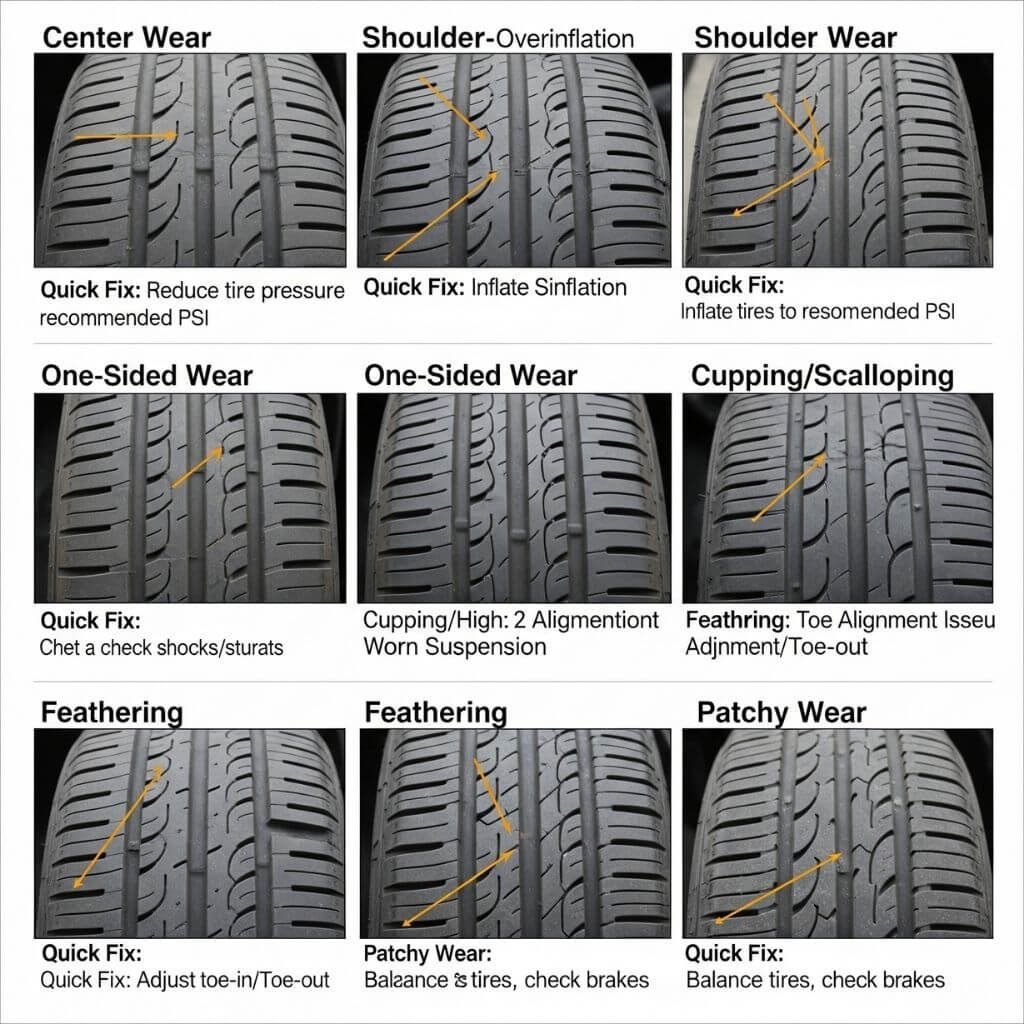
Troubleshooting: Common Wear Patterns & Solutions
Tires often show early warning signs before a bigger problem develops. By learning what different wear patterns mean, you can fix small issues before they cost you a full set of tires. Here are the most common patterns and what to do about them:
1. Inner Edge Wear
- What it looks like: The inside edge of the tire is worn down faster than the rest.
- Likely cause: Misalignment, often due to the wheels tilting inward (negative camber).
- Solution: Get a professional wheel alignment. This resets the angles so the tire sits flat on the road.
2. Center Wear
- What it looks like: The middle of the tire tread wears out faster than the edges.
- Likely cause: Overinflation — too much air pressure makes the center bulge out.
- Solution: Lower tire pressure to the manufacturer’s recommended level (check the sticker inside the driver’s door).
3. Feathering or Sawtooth Wear
- What it looks like: Tread blocks feel sharp on one side and smooth on the other, almost like tiny “teeth.”
- Likely cause: Toe misalignment (tires angled inward or outward too much) or worn suspension parts.
- Solution: Schedule an alignment check and inspect shocks or bushings.
4. Cupping
- What it looks like: Patchy dips or scalloped areas across the tread.
- Likely cause: Out-of-balance tires or suspension issues like worn shocks.
- Solution: Balance the tires and replace worn suspension parts.
5. Vibration or Pull
- What it feels like: The steering wheel shakes at speed, or the car pulls to one side.
- Likely cause: Tire imbalance, poor alignment, or even a damaged tire.
- Solution: Start with balancing and alignment. If the problem continues, have the tire inspected for internal damage.
Seasonal & Special-Condition Tips
Tires face different challenges depending on the season or how you drive. A few small habits can keep you safe and extend tire life.
Winter
Cold air lowers tire pressure, so check it more often. If you live in a snowy area, consider switching to winter tires for better grip. Store your summer tires in a cool, dry place away from sunlight until you need them again.
Summer
Hot roads and high heat put extra stress on tires. Check for cracks, bulges, or signs of wear. Be extra alert for blowouts during long highway drives.
Off-Road
Rough trails can damage sidewalls. After each trip, inspect your tires carefully and remove any stones or debris stuck in the tread.
Road Trips
Before hitting the highway, do a quick tire checklist: check pressure, make sure your spare is ready, and carry a small repair kit or portable air pump. These steps can save time and prevent roadside trouble.
👉 Taking a few minutes to adjust your tire care to the season or driving conditions keeps your ride safer and your tires lasting longer.
Customer Feedback & Review Aggregation
Listening to real drivers helps you understand how tires perform in everyday use. Collecting and presenting feedback the right way makes your guide more trustworthy and useful.
How to gather feedback:
- Run a quick survey for your readers.
- Read through car forums and paraphrase useful comments (always link to the source).
- Summarize verified reviews from retailers.
- Ask past buyers to share short testimonials.
What to present:
- A star-rating summary (average score).
- Top 5 praises (e.g., long tread life, quiet ride, good wet grip).
- Top 5 complaints (e.g., faster wear, noise on highways, poor winter traction).
How to show it:
- Use short quote blocks with a person’s first name or “anonymous driver.”
- Create a pros/cons table for quick scanning.
- Write a short summary paragraph to highlight patterns. For example: “Most users who rotated their tires every 6,000 miles reported about 20% longer life.”
Legal reminder: Always get permission before using direct quotes. If using forum posts, anonymize the writer or paraphrase their words.
👉 This approach gives readers a clear picture of real-world performance without overwhelming them with raw data.
Sources & Further Reading
When it comes to tire care, it’s always best to double-check with trusted sources. Below are some helpful places where you can find reliable information:
- NHTSA (National Highway Traffic Safety Administration): Safety tips and tire care advice.
- AAA: Practical guides for drivers, including seasonal maintenance.
- Tire Rack: Tire reviews, comparisons, and buying advice.
- Consumer Reports: Independent testing and ratings for different tire brands.
- Manufacturer websites (Michelin, Goodyear, Bridgestone, etc.): Detailed product information, care instructions, and warranty details.
You should also look at your vehicle owner’s manual and the tire warranty guide from the manufacturer. These give you the most accurate instructions for your specific car and tires.
By using both general expert resources and brand-specific guidance, you’ll make smarter choices, keep your car safe, and help your tires last longer.
FAQ
Q1. How often should I rotate my tires?
Most experts recommend rotating tires every 5,000 to 7,500 miles, or about every other oil change. Regular rotation helps tires wear evenly, improves handling, and can extend tire life by thousands of miles. Always follow your vehicle’s manual for the best schedule.
Q2. What is the correct tire pressure for my car?
The correct tire pressure depends on your vehicle, not the tire itself. You can find the recommended PSI on the sticker inside the driver’s door or in the owner’s manual. Checking monthly and before long trips keeps your tires safe and efficient.
Q3. Can a punctured tire be repaired?
Small punctures in the tread area can often be patched or plugged by a professional. However, damage on the sidewall or large holes usually mean the tire must be replaced. Driving on a flat for too long can also make repair impossible.
Q4. How long do tires last with good maintenance?
With proper care—like regular rotation, correct pressure, and alignment—most tires last 40,000 to 60,000 miles, or about 4–6 years. Extreme weather, rough roads, or poor maintenance can shorten this lifespan. Always check tread depth and replace worn tires early.
Q5. Is a tire dressing safe to use?
Yes, but choose carefully. Water-based dressings are safest and help keep rubber flexible. Some silicone-based or petroleum-heavy products can dry out or crack the rubber over time. Always follow product directions and avoid heavy overspray near sensors or brake parts.
Q6. Does tire pressure affect fuel economy?
Yes. Underinflated tires create more rolling resistance, which forces your engine to work harder and burn more fuel. According to the U.S. Department of Energy, keeping your tires properly inflated can improve gas mileage by up to 3%.
Q7. Should I use winter tires in all seasons?
Winter tires are designed with softer rubber that grips in cold weather, but they wear quickly in heat. It’s best to use them only during winter months and switch back to all-season or summer tires once temperatures rise.
Q8. How do I know when to replace my tires?
Check tread depth with the penny test: insert a penny into the tread with Lincoln’s head upside down. If you can see his entire head, the tread is too low and it’s time for new tires. Also replace if you see cracks, bulges, or uneven wear.
Conclusion
Taking care of your tires doesn’t have to be complicated. With a few regular habits—like checking air pressure, rotating on schedule, and watching for uneven wear—you can keep your tires in good shape for longer. This not only saves money but also keeps you and your passengers safer on the road.
Remember, every car and tire brand may have slightly different needs. Always check your vehicle’s owner’s manual and the tire manufacturer’s guidelines. A little attention now can prevent bigger problems later.
In short: treat your tires well, and they’ll return the favor with better performance, smoother rides, and longer life.
